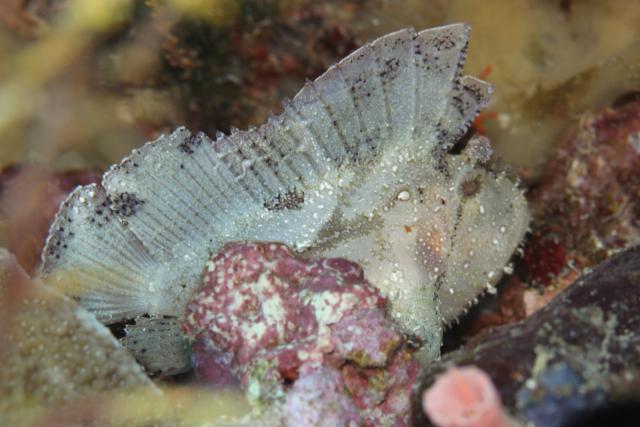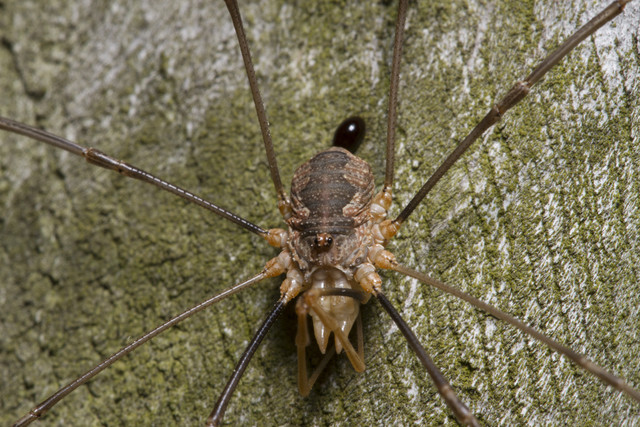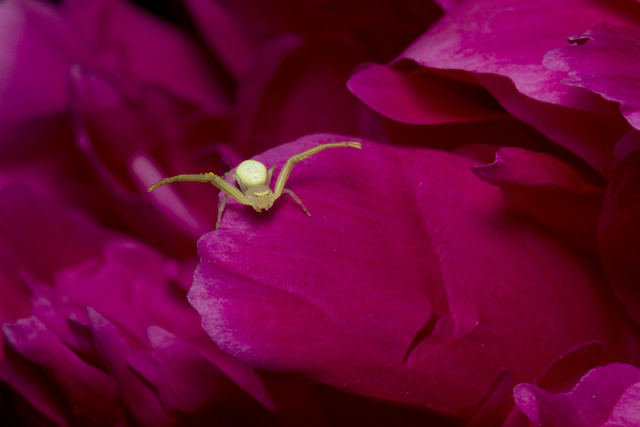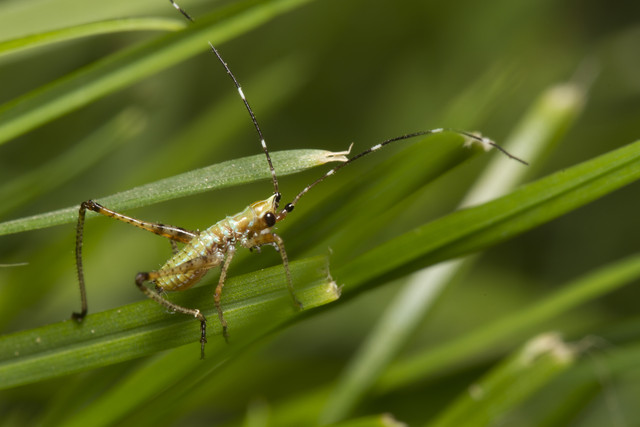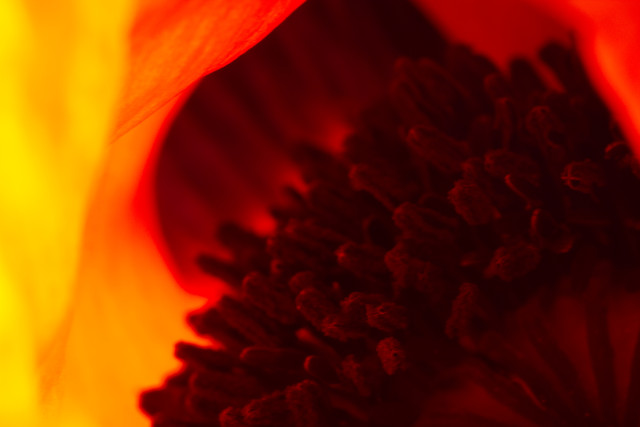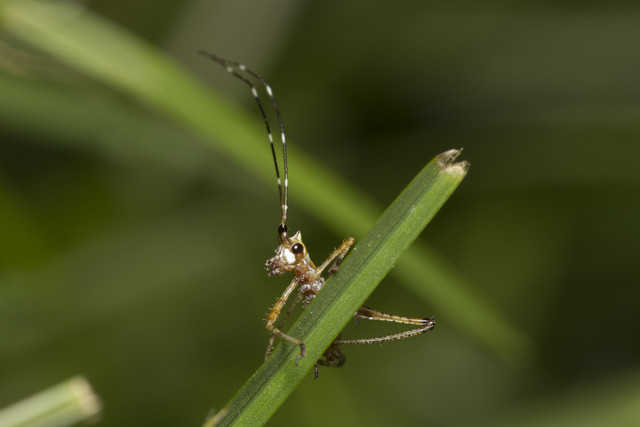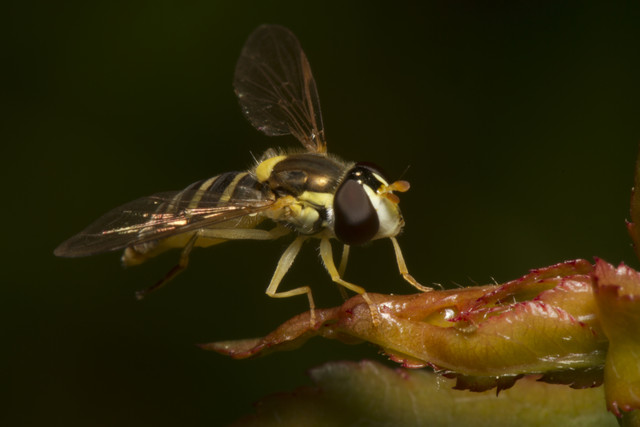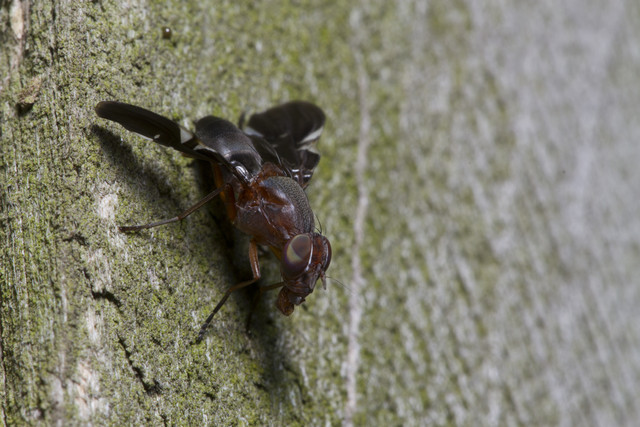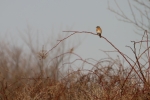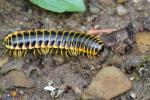flash
Wakatobi: Leaf Scorpionfish
ktuli — Wed, 06/22/2011 - 20:42
Just a quick shot to share today. This cryptically camouflaged critter is a Leaf Scorpionfish (Taenianotus triacanthus). They are sometimes so hard to spot that one member of our group was actually looking past the one we were pointing to, trying to figure out what was hiding behind it that we could have been pointing to! These little guys even sway in the water to mimic a dead leaf or seaweed.
Technical Data: Canon EOS 7D, Canon EF 100mm f/2.8L Macro IS USM, 1/25th sec at f/8. Image Stabilization on. ISO 400 (Auto). Ikelite Housing and Port with Ikelite 161 Strobe in TTL Mode. Auto-smartfix and Removed Color Cast in Photoshop Elements 8.0 (mouseover for original)
I really wish I could go diving soon. Like, really soon.
- Bill
Poll: Katydid Nymph (part 3)
ktuli — Fri, 06/10/2011 - 06:40
So after looking at the shot from the other day, and thinking about the elements that I wished could have been improved with that shot, I decided that perhaps a simple crop would make the shot better.
So here's the crop and the original... place your vote and let me know which one you think looks better.
 Original |
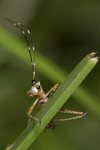 Cropped |
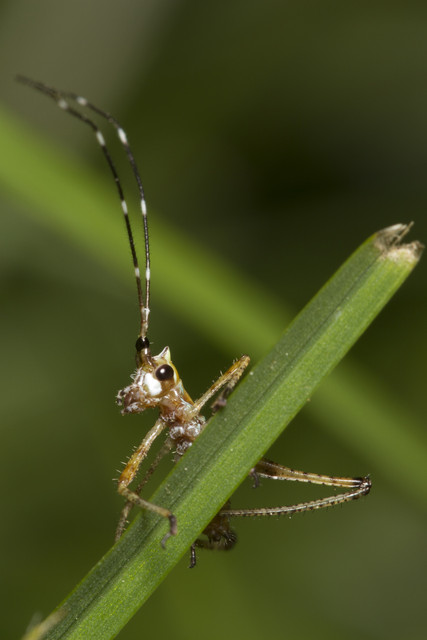 |
|
Technical Data: Canon EOS 7D, Canon EF 100mm f/2.8L Macro IS USM, 1/250 sec at f/11. Canon Speedlight 580EX II flash in auto mode and wireless control. Image Stabilization on. ISO 160. RAW processing in Adobe Camera Raw.
As usual, place your vote and then drop me a comment and let me know why you chose the one you chose.
- Bill
Harvestman
ktuli — Wed, 06/08/2011 - 18:45
Ok - I will admit... if you don't like spiders, you probably won't like this shot. Though technically, this isn't a spider. It is in the arachnid class, but it is in the Opiliones order.
But either way, they are much more alien looking than spiders (and if I'm honest, much uglier!).
Their common names are Harvestmen or Daddy-Longlegs, and you've likely seen them before but probably not like this.
They differ from spiders in a number of ways. First, they possess no silk glands nor venom glands - so they're completely harmless (though this one seems to have something that looks like semi-large fangs). Their body segments are fused (spiders have two body segments - cephalothorax and abdomen), and only have a single pair of eyes (spiders have four pairs of eyes). Harvestmen can also eat solid foods, whereas spiders are only able to ingest liquids.
Ok - if you're still here with me... you must be willing to see the shot...
Technical Data: Canon EOS 7D, Canon EF 100mm f/2.8L Macro IS USM, 1/250 sec at f/11. Canon Speedlight 580EX II flash in auto mode and wireless control. Image Stabilization on. ISO 160. RAW processing in Adobe Camera Raw.
Obviously, the legs on this guy weren't even going to come close to staying in the frame if I was going to get the same level of detail on the body. Most of those legs don't even have the first joint in the shot. The body on this harvestman was maybe 5mm long, so extremely tiny.
Pretty hard to get the detail here but I think I did pretty well.
My apologies if you're freaked out by that shot...
- Bill
Return of the Crab Spider (part 2)
ktuli — Tue, 06/07/2011 - 17:16
Ok - back to the crab spider that was living in one of the peony flowers in our garden for today. This was a very tiny little spider, and today's shot gives a little more scale by backing up a little and showing more of the flower along with the spider.
Technical Data: Canon EOS 7D, Canon EF 100mm f/2.8L Macro IS USM, 1/250 sec at f/16. Canon Speedlight 580EX II flash in auto mode and wireless control. Image Stabilization on. ISO 160. RAW processing in Adobe Camera Raw.
By backing up a little, I manage to show a little scale (though nothing near normal size). I think often times, folks think that these bugs I find are the size of my hand because of the magnification the macro lens produces. In reality (and if my math is correct) had an arm span of only about 9-11mm. Pretty tiny.
The other thing this shot shows is some of the behavior of the crab spider. (This part will probably creep out those of you who don't like spiders, so skip the rest of this paragraph if you're in that group). Crab spiders are pretty aggressive. They often take down prey much much larger than themselves, and they do that with those long, powerful, front legs. They lie in wait and pounce on their prey, holding it with those long legs while injecting their venom. Both crab spiders that I have photographed showed basically no fear of me at all, including threat displays and lunging forward towards my hands and the camera. Very impressive little attitudes. Despite their attitudes and ability to take down large prey, they are harmless to humans.
Often times, crab spiders live on flowers that are close to the color they are (some can slightly change their colors to match the flowers exactly), so this little guy living in a pink flower is kind of strange. The camouflage at work here is actually based on the pollen stamens in the flower. When hiding between the petals, this little spider was about the size and color of the yellow pollen stamens which are layered between the different petals in a peony flower. And it was very quick to move around the flower, quickly climbing between petals, crawling from one side to the other side of a petal, and traversing the whole flower with surprising speed - though it never moved very quickly, just very directly.
See - there are reasons why I am fascinated by little critters like this. I know they're often considered creepy or even scary, but they really are interesting creatures.
- Bill
Katydid Nymph (part 2)
ktuli — Mon, 06/06/2011 - 19:54
Well, like I said, it was a short respite from the bug photos (sorry mom) and we're bouncing back to the katydid nymph from the other night.
This is another one from towards the end of the shoot when I was laying in the grass to get the low perspective to put the view in the katydid nymph's world. That's part of the allure of macro photography for me - to be transported to different worlds that exist right under our feet just by looking through the lens.
Technical Data: Canon EOS 7D, Canon EF 100mm f/2.8L Macro IS USM, 1/250 sec at f/16. Canon Speedlight 580EX II flash in auto mode and wireless control. Image Stabilization on. ISO 160. RAW processing in Adobe Camera Raw.
What Works: Again, a lot of the elements from the shot the other day work again here. The one added nice feature here that makes the shot a little more appealing is the fact that the front leg blocks the mouth parts a bit - I have to be honest and say that this little critter has some weird mouth parts that are probably a bit creepy to some folks, so getting them partially obscured probably is a good thing.
What Doesn't Work: Again here, the shot was taken on such a weird angle - technically the camera interpreted the shot as a vertical shot, but I rotated it back 90 degrees clockwise. The only problem with that is that the grass doesn't necessarily come from the bottom of the frame then. Again, another bright blade of grass in the background is a distraction.
If you like the bug shots, stay tuned as I have a couple more days worth to share. Thanks for stopping by.
- Bill
Flashed Poppy
ktuli — Sun, 06/05/2011 - 21:11
 I stopped by my parents' house this afternoon, and had a request for fewer bug shots. I have a stack of bug shots to share, so this will be a quick break (sorry, mom).
I stopped by my parents' house this afternoon, and had a request for fewer bug shots. I have a stack of bug shots to share, so this will be a quick break (sorry, mom).
These shots are of a poppy blossom. Though the perspective and the lighting and the end result are kind of interesting.
First, the view is a macro view down inside the blossom of the pollen stamens. While that isn't necessarily unique, the lighting is kind of interesting. I used my flash to shine up through the petals of the flower to illuminate the shot.
The result is that the light is diffused through the petals and picked up the reddish-orange color. So while the pollen stamens were black, they appear red in the shot.
Technical Data: Canon EOS 7D, Canon EF 100mm f/2.8L Macro IS USM, 1/250 sec at f/16. Canon Speedlight 580EX II flash in auto mode and wireless control. Image Stabilization on. ISO 160. RAW processing in Adobe Camera Raw.
The shots were challenging to get because I hand-held the whole thing. With one hand, I was holding the camera with the 100mm macro (not a light setup) trying to keep it at the minimum focusing distance, and with the other hand I was reaching below the flower to illuminate the shot. I probably should have been using at least one tripod (possibly two) to do all of this, but i simply couldn't be bothered... as usual.
I really like how the shots become an abstract view, and almost have the feel of an electron microscope view.
Technical Data: Canon EOS 7D, Canon EF 100mm f/2.8L Macro IS USM, 1/250 sec at f/16. Canon Speedlight 580EX II flash in auto mode and wireless control. Image Stabilization on. ISO 160. RAW processing in Adobe Camera Raw.
Interesting, no? Drop me a comment and let me know what you think. Sorry - tomorrow, we go back to the bugs.
- Bill
Posing Katydid Nymph
ktuli — Fri, 06/03/2011 - 16:19
Ok - we'll get back to the crab spider soon, I promise. But last night I went out to see about photographing the crab spider again, and happened to find this little guy...
Technical Data: Canon EOS 7D, Canon EF 100mm f/2.8L Macro IS USM, 1/250 sec at f/11. Canon Speedlight 580EX II flash in auto mode and wireless control. Image Stabilization on. ISO 160. RAW processing in Adobe Camera Raw.
Why This Photo: I've never seen a katydid nymph like this before, and I decided to spend some time with it to see what kind of good shots I could come up with. When I saw it climbing on this blade of grass, I figured a good pose would come of it, and when I saw it get into the classic tree-frog pose, I fired off a shot. I think it's a keeper...
What Works: First, the pose is the biggest thing here... I literally waited and worked with this katydid nymph for 35 minutes to get this shot. I also moved from position to position - starting on a peony flower, down to some hosta leaves, and finally down to the grass. To get the shot, I was laying on the ground so I could get an eye-level view of the katydid nymph. The focus is sharp, and the depth of field has almost the whole katydid nymph in clarity (except for the ends of the antennae).
What Doesn't Work: The bright blade of grass running the opposite angle in the background is somewhat distracting, and the white patch on the katydid nymph's face below its eye is a little over-powering (though that is how it was, so there isn't much I could do about it).
I think the main point from this is that I was rewarded by following some of those "rules" to photography. I worked with the subject to make sure I took multiple shots with multiple angles to provide myself with a higher possibility of scoring a nice photo. I also got down to eye level - even if it meant laying in the grass - so that the shot was engaging rather than flat. Finally I observed my subject and waited for that decisive moment to present itself.
I have more shots of this little guy, and I'll be sharing them and the crab spider shots next week. Thanks for stopping by.
- Bill
Return of the Crab Spider
ktuli — Thu, 06/02/2011 - 19:54
Yeah - I know... that sounds like a B horror film title, but if you remember - I had a run-in with a crab spider last year too (posts: 1, 2, and 3). Unfortunately, I have some more photos to process tonight, so just sharing one photo, and I'll discuss details on future posts.
Technical Data: Canon EOS 7D, Canon EF 100mm f/2.8L Macro IS USM with Kenko Teleplus PRO 300 "DG" AF 2x Teleconverter, 1/250 sec at f/16. Canon Speedlight 580EX II flash in auto mode and wireless control. Image Stabilization on. ISO 160. RAW processing in Adobe Camera Raw.
I have some really fun stuff to share... soon.
- Bill
Getting Closer: Bug Macros
ktuli — Tue, 05/31/2011 - 21:21
I know they're not popular with most folks, but I really like macro photos - particularly of insects. I've really been trying to improve my techniques to get better macro shots, and recently, I managed to achieve some better shots that included macro focus that actually shows the multi-faceted eyes of the bugs I was shooting.
Technical Data: Canon EOS 7D, Canon EF 100mm f/2.8L Macro IS USM with Kenko Teleplus PRO 300 "DG" AF 2x Teleconverter, 1/250 sec at f/16. Canon Speedlight 580EX II flash in auto mode and wireless control. Image Stabilization on. ISO 160. RAW processing in Adobe Camera Raw. Full size.
Technical Data: Canon EOS 7D, Canon EF 100mm f/2.8L Macro IS USM, 1/250 sec at f/16. Canon Speedlight 580EX II flash in auto mode and wireless control. Image Stabilization on. ISO 160. RAW processing in Adobe Camera Raw. Full size.
It isn't easy to see in the resized versions, but in the full size versions, you can most definitely see the facets of the eyes on these bugs. Maybe some more work and I can nail these kinds of shots all the time.
Though I'm sure plenty of folks won't be pleased to see more bugs on the site...
- Bill
Pink Dogwood Blossoms
ktuli — Fri, 05/27/2011 - 18:08
Ok - as promised, here is the calm flower photo to make up for yesterday's spider shots...
Technical Data: Canon EOS 7D, Canon EF 100mm f/2.8L Macro IS USM, 1/250 sec at f/2.8. Canon Speedlight 580EX II flash in auto mode and wireless control. Image Stabilization on. ISO 400. RAW processing in Adobe Camera Raw.
I took several different exposures of this shot, but I really like the almost dreamy feel that this one has because of the extremely wide aperture (f/2.8). Drop me a comment and let me know what you think.
- Bill

